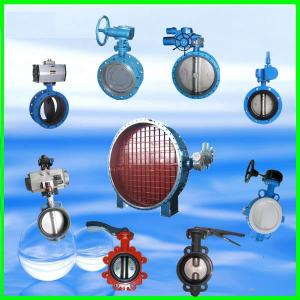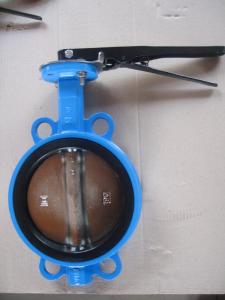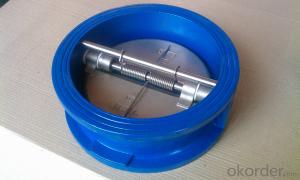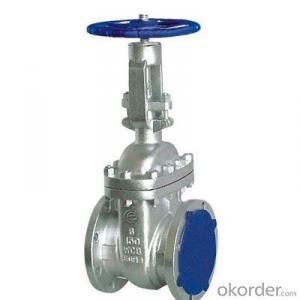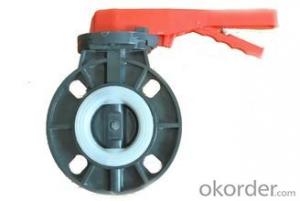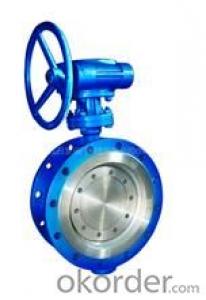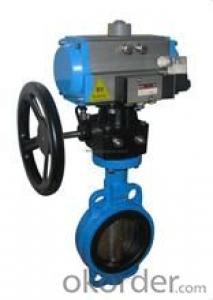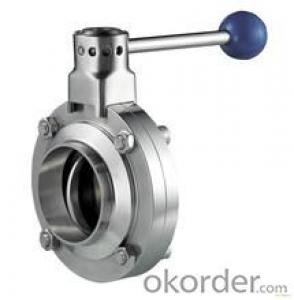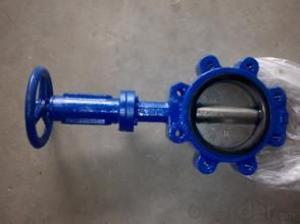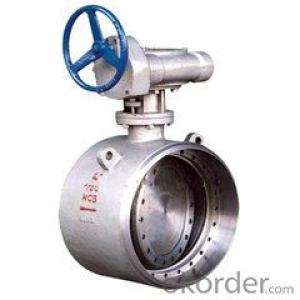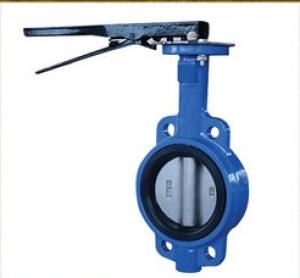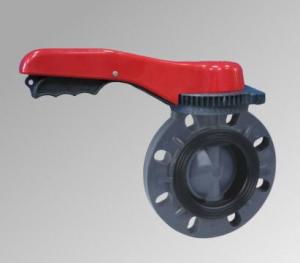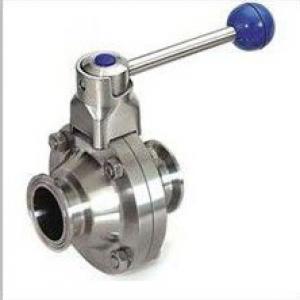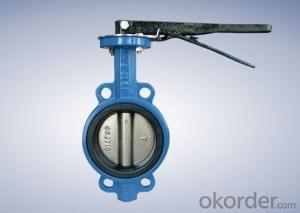butterfly valve 360°polished disc assures positive on-off Place of Origin: China (Mainland)
- Loading Port:
- Tianjin
- Payment Terms:
- TT OR LC
- Min Order Qty:
- 1 pc
- Supply Capability:
- 9999 pc/month
OKorder Service Pledge
OKorder Financial Service
You Might Also Like
Quick Details
Standard or Nonstandard: Standard Structure: Butterfly Pressure: Low Pressure Power: Manual Material: Casting Temperature of Media: Normal Temperature Media: Water Port Size: DN40-DN1200 Place of Origin: China (Mainland) Wafer type: butterfly valve Packaging & Delivery
Packaging Details: Plactic bag+Paper cover+Plywood cases
Delivery Detail: Within 20 days
Specifications
Wafer type lined butterfly valve
1.Design standard:ISO,BS,API
2.DN40-DN1200
3.PN10/PN16/PN25
4.Center lined disc
Wafer type lined butterfly valve
Technical Data
DN40-DN1200mm PN1.0-1.6MPa
General Design:ISO 5752 / BS 5155 / API 609
Body: Cast Iron, Ductile Iron, Carbon Steel, Stainless Steel
Seat: EPDM, PTFE, NBR,Viton
Stem: Stainless Steel, Steel,
Disc: Ductile Iron with Nickel Coating,Ductile Iron with Nylon Coating, Stainless Stee 304/316l, Alu-Bronze,Duplex steel
Flange Connection:DIN,ANSI,JIS,BS
Product Features
Wafer type flanged body style fit between FF or RF flanges
PTFE bushing ensure the maximum shaft support and centralized alignment
360°polished disc assures positive on-off
Hard-Backed Cartridge seat or Edge-Boot seat
The pin,spline or square connection are all available
Universal ISO 5211 mounting pad.
- Q: What is the meaning of the D341*5-10 / 16ZB1 turbine butterfly valve flange said?
- Liu1964tg, this guy is right, don't know, don't mislead everybody
- Q: In the pipeline attached building Atlas 05S502, in the middle of a water meter and check valve, the two sides are divided into two butterfly valve, want to ask why to arrange this way, what is the role of the two butterfly valve?
- Check the water gauge and check valve on both sides to facilitate the maintenance and replacement of water meter and check valve.
- Q: Have an iron block, aluminum heads, solid roller lifters, Jessel rocker shafts, what should my valve clearances be cold, and hot??
- Well, generally it's going to be .030 intake and exhaust (hot). Adjust to those clearances cold then recheck at operating temp. But it would really help to know year, make, cu. in., which aftermarket heads, to be absolutely sure. On some engines it is .024 intake / .030 exhaust and so on, depends on the lifters and valve train geometry.. What brand of lifters and cam profile? Usually they will specify valve lash and adjusting procedures. Edit: Wow, kinda' tight valve lash, krazybob, ( might be a lttle tough on the old cam lobes), and then there is your timing numbers / advice with absolutely no details to base it on ( H.E.I.?..which brand? / mechanical advance curve?, and vacuum advance numbers?, cam timing, brand of lifters, cam specs, rocker arm ratio)...Look, S-51D, the best idea is to Do- It- Right using the correct adjustment specs. The data is out there, once the configuration is identified.
- Q: What do D71, D371 and D341 represent in butterfly valves?
- D71 in D is the meaning of butterfly valve, 7 refers to the connection is the clamp, and 1 refers to the butterfly plate is the center of verticalD371 in D is the meaning of butterfly valve, 3 refers to the drive mode is the turbine, 7 refers to the connection is the clamp, and 1 refers to the butterfly plate is the center of verticalD341 in D is the meaning of butterfly valve, 3 refers to the drive is turbine, 4 refers to the connection is flange connection, and 1 refers to the butterfly plate is the center of vertical. China valve Holding Group Co., Ltd. Zhang Chao 021-55601036 Fax: 021-66289822
- Q: The difference between the electric control valve and the electric butterfly valve, respectively, the application situation
- Both are powered by electric butterfly valves.The control valve must have the ability to accept external signal control. At the same time, control signals and valves through the medium flow must ensure a certain relationship.Electric control valve belongs to electric butterfly valve; electric butterfly valve butterfly valve including but not exclusively butterfly valve.Electric butterfly valve is a kind of electric control valve.There are many types of valve body, usually through the single seat, straight through two seat, angle, diaphragm, small flow, three pass, eccentric rotation, butterfly, sleeve type, spherical and so on 10. In the selection of control valve valve prior to the media, process conditions and parameters to control the process of careful analysis, to collect sufficient data to understand the system requirements on the control valve, according to the data collected to determine the type of valve to be used.
- Q: What is the medium flow rate when the centerline butterfly valve is fully open?
- On the pipeline, mainly from cutting and throttling. Butterfly valve headstock is a disc shaped disc, in the valve body around its own axis of rotation, so as to achieve the purpose of opening or closing or regulation.
- Q: Is the pressure test of the centerline butterfly valve checked or checked?
- Every factory factory must require pressure tests.
- Q: My bike has now 6200 miles on the odometer. The manual says that a valve adjustment should be performed every 6000 miles. But the bike runs fine. Can I just have the valve checked or should I have them adjusted even though the bike is fine? What will happen if I just keep riding it?
- if the valves are not chattering (WOrse then normal) and you havent lost power or gas milage, then no...dont get it adjusted and no ... your not hurting the bike.
- Q: I did a compression check on my 350 chevy. I have low compression of 175psi on one cylinder.The other seven cylinders range from 195psi to 205psi Could the valves be too tight on the cylinder with 175 psi compression?
- Chev engines have hydraulic lifters, keeping the valves adjusted correctly at all times. 20 lbs isn't much to worry about anyway, but if you want dump a little oil (about a tablespoons worth) into that cylinder and recheck it. If the compression jumps up, then your rings are getting weak. If not, you may have a leaky valve.
- Q: Buried extension butterfly valve is buried or need to repair the valve well, can build the valve well, the extension rod butterfly valve installed in the valve well, the extension rod to avoid covers, the top of the valve well out, so that the hand wheel in the ground operation.Atlas S143 is less than the inner diameter of DN150 valve wells only 1200mm, DN200-DN250D diameter of only 1400mm, 700mm valve covers, valve rod and a handwheel to lengthen through the valve cover, valve wells is built to cover the embedded pipe or tube? Is there a standard atlas?
- The establishment of a repair valve well, easy to repair, usually hydrogen long rod butterfly valve installed in the well. But if the quality of buying long stem butterfly valve, it can also be buried directly, not easy to bad
Send your message to us
butterfly valve 360°polished disc assures positive on-off Place of Origin: China (Mainland)
- Loading Port:
- Tianjin
- Payment Terms:
- TT OR LC
- Min Order Qty:
- 1 pc
- Supply Capability:
- 9999 pc/month
OKorder Service Pledge
OKorder Financial Service
Similar products
Hot products
Hot Searches



